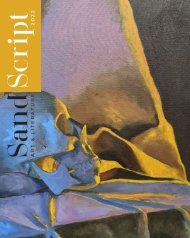SandScript 2023 [Digital Exclusive]
You also want an ePaper? Increase the reach of your titles
YUMPU automatically turns print PDFs into web optimized ePapers that Google loves.
This experiment of Jackendoff’s and Mora’s previous explanation shows the universality of<br />
which Holdaway speaks when students’ memories are stimulated by music. They end up<br />
being more creative than what was first expected. Everything that the learner was hearing and<br />
mentally forming came out linguistically, as in Jackendoff’s experiment with the use of both<br />
English and Spanish. The music helps encode the language in the learners’ minds by allowing<br />
them to take their imagination farther and make them realize they have so much more stored in<br />
their brain then they realize.<br />
Music is indeed very much linked to the way a student learns language. In order for<br />
the students to learn something correctly, the instructor must take an active interest in how<br />
the students are learning and what approaches are really working. “While many lay people<br />
might think that the most important aspect of music is to play the notes correctly, the best<br />
music teachers take a strong interest in laying in their students’ minds a solid foundation of<br />
the concept of rhythm” (Giauque 5). To learn a foreign language, the students need to have<br />
a strong pattern to follow, and they need to learn the “rhythm” of speech, sentence structure,<br />
and vocabulary. The best way for the student to learn is if all the components are broken<br />
down for them in a simple style (Giauque 4). By creating comfortable learning environments<br />
that allow creativity to flow and interconnect with language, instructors offer a safe haven<br />
for students to develop new language skills. If we expect students to learn, we the educators<br />
need to introduce activities and exercises that will allow for the information to be burned into<br />
their memory. Understanding how music and language work in tandem is one key used to<br />
unlock this door to learning.<br />
BIBLIOGRAPHY<br />
Giauque, Gerald S. “Foreign Language Acquisition and the Study of Music.” U.S.<br />
Arizona (October 1985) 9.<br />
Holdaway, D. The Foundations of Literacy. Sydney, NSW: Ashton Scholastic (1979).<br />
Huffine, Karen, and DiAnn Ellis. “Stories That Sing: Stimulating Oral Language in<br />
Young Children.” U.S. California (February 1979) 18.<br />
Jackendoff, Ray Languages of the Mind: Essays on Mental Representations. Cambridge,<br />
Mass: MIT Press. 1992.<br />
James, Alan Russell. “When I Listen to Music.” Young Children 55.3 (May 2000) 36-7.<br />
Mora, Carmen Fonseca. “Foreign Language Acquisition and Melody Singing.” ELT<br />
Journal 54.2 (April 2000) 147-60.<br />
202


![SandScript 2023 [Digital Exclusive]](https://img.yumpu.com/68282062/205/500x640/sandscript-2023-digital-exclusive.jpg)



